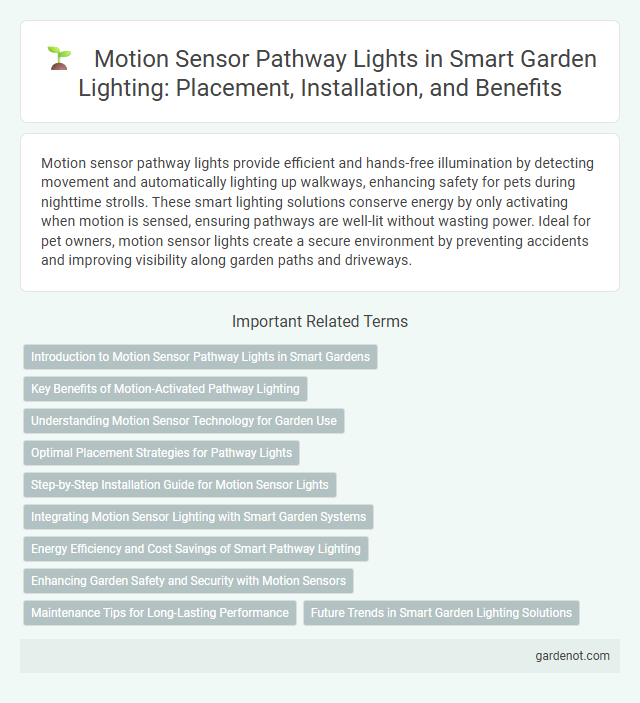Motion sensor pathway lights provide efficient and hands-free illumination by detecting movement and automatically lighting up walkways, enhancing safety for pets during nighttime strolls. These smart lighting solutions conserve energy by only activating when motion is sensed, ensuring pathways are well-lit without wasting power. Ideal for pet owners, motion sensor lights create a secure environment by preventing accidents and improving visibility along garden paths and driveways.
Introduction to Motion Sensor Pathway Lights in Smart Gardens
Motion sensor pathway lights enhance smart gardens by automatically illuminating walkways when movement is detected, improving safety and convenience. These lights use infrared or ultrasonic sensors to detect motion, activating energy-efficient LEDs only when needed, reducing power consumption. Integration with smart home systems allows customizable lighting schedules and remote control for optimized garden aesthetics and security.
Key Benefits of Motion-Activated Pathway Lighting
Motion-activated pathway lighting enhances home security by deterring intruders with sudden illumination. These energy-efficient lights only activate when motion is detected, reducing electricity consumption and extending bulb lifespan. Improved visibility along walkways also prevents accidents, ensuring safer navigation during nighttime.
Understanding Motion Sensor Technology for Garden Use
Motion sensor pathway lights for garden use operate by detecting infrared heat or movement within a preset range, activating illumination to enhance safety and ambiance. These sensors utilize Passive Infrared (PIR) technology to sense body heat or microwave sensors for motion detection, adjusting sensitivity and duration to reduce false triggers from animals or environmental factors. Integrating energy-efficient LED bulbs with smart motion sensors ensures optimal brightness while conserving power in outdoor garden pathways.
Optimal Placement Strategies for Pathway Lights
Optimal placement of motion sensor pathway lights involves positioning them at intervals of 6 to 8 feet along walkways to ensure consistent illumination and enhance safety. Installing sensors at a height of 6 to 10 feet maximizes detection range, allowing timely activation when motion is detected. Placement near potential obstacles such as steps or uneven surfaces improves visibility and prevents accidents during nighttime navigation.
Step-by-Step Installation Guide for Motion Sensor Lights
Install motion sensor pathway lights by first selecting an optimal location with clear sensor visibility and appropriate illumination coverage. Secure the mounting bracket or stake firmly into the ground, then connect the wiring according to the manufacturer's instructions, ensuring a waterproof seal for outdoor use. Activate the sensor and test the motion detection range and light duration settings to optimize performance and energy efficiency.
Integrating Motion Sensor Lighting with Smart Garden Systems
Integrating motion sensor pathway lights with smart garden systems enhances energy efficiency by activating lighting only when movement is detected, reducing unnecessary power consumption. These intelligent lights can be programmed to sync with garden irrigation and security systems, providing a cohesive and responsive outdoor environment. Advanced motion sensors use adaptive sensitivity and wireless connectivity to optimize illumination based on real-time activity and environmental conditions.
Energy Efficiency and Cost Savings of Smart Pathway Lighting
Motion sensor pathway lights significantly enhance energy efficiency by activating illumination only when movement is detected, minimizing unnecessary power consumption. This targeted lighting reduces electricity bills and extends bulb lifespan, offering substantial cost savings over time. Integrating smart sensors with LED technology further optimizes energy usage while maintaining safety and visibility along walkways.
Enhancing Garden Safety and Security with Motion Sensors
Motion sensor pathway lights significantly enhance garden safety by automatically illuminating walkways when movement is detected, reducing the risk of trips and falls during nighttime. These smart lighting solutions also improve security by deterring intruders through sudden, bright activation upon sensing motion. Integrating motion sensors with energy-efficient LED technology ensures long-lasting performance and reduced electricity consumption while safeguarding outdoor spaces.
Maintenance Tips for Long-Lasting Performance
Regularly clean the motion sensor pathway light's lens and housing to prevent dirt and debris from affecting sensor sensitivity and light output. Check and replace batteries or power sources promptly to maintain consistent operation, especially in battery-powered models. Periodically test the sensor's detection range and adjust its angle for optimal coverage and energy efficiency.
Future Trends in Smart Garden Lighting Solutions
Motion sensor pathway lights are increasingly integrating AI-driven adaptive lighting to enhance energy efficiency and user convenience in smart garden lighting. Future trends emphasize seamless connectivity with smart home ecosystems, enabling personalized illumination based on real-time environmental data and user behavior patterns. Enhanced motion detection technology will offer precise activation, reducing light pollution and extending battery life for sustainable outdoor lighting solutions.
Motion sensor pathway light Infographic

 gardenot.com
gardenot.com